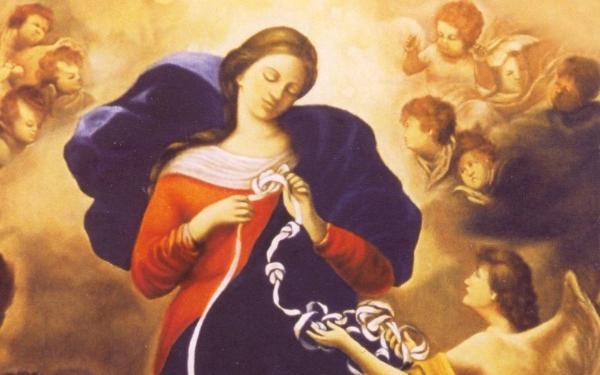Mary who unties the knots: the true story of devotion
The first chapel called "Maria who unties the knots" was completed in 1989 in Styria, Austria, inspired as a plea in response to the Chernobyl nuclear tragedy. The image of "Mary who unties the knots" is particularly revered in Argentina and Brazil, where churches have been named for her and devotion to her has become widespread and that the Guardian has called a "religious mania".
This Catholic devotion has grown since Jorge Mario Bergoglio, SJ (who would later become Pope Francis after a mandate as archbishop of Buenos Aires), brought a postcard of the painting to Argentina in the 80s after seeing the original while studying in Germany. Devotion reached Brazil in the late 20th century. According to Regina Novaes, of the Institute of Religious Studies of Rio de Janeiro, Maria who unties the knots "attracts people with small problems". Bergoglio had this image of Mary engraved on a chalice which he presented to Pope Benedict XVI and another chalice bearing his image, the work of the same silversmith, will be presented to Pope Francis on behalf of the Argentine people.
In Buenos Aires, a copy of the icon was made and left by the artist, Dr. Ana de Betta Berti, for the Church of San José del Talar, which has kept it since December 8, 1996. every month, thousands of people make the pilgrimage to this church.
Knowing Pope Francis' special devotion to this image, a new South Korean ambassador to the Vatican in 2018, Baek Man Lee, presented him with a Korean painting of Our Lady that unties the knots.
The painting was donated around 1700 by Hieronymus Ambrosius Langenmantel (1641-1718), a canon of the monastery of San Pietro in Augusta. The donation is said to be linked to an event in his family. His grandfather Wolfgang Langenmantel (1586-1637) was on the verge of separation from his wife Sophia Rentz (1590-1649) and therefore sought help from Jakob Rem, the Jesuit priest of Ingolstadt. Father Rem prayed to the Blessed Virgin Mary and said: "In diesem religiösen Akt erhebe ich das Band der Ehe, löse alle Knoten und glätte es [In this religious act, I lift the bonds of marriage, to untie all the knots and lighten them ] ". Peace was immediately restored between husband and wife, and the separation did not take place. In memory of this event, their nephew commissioned the painting of "Maria who unties the knots".
The painting, executed in Baroque style by Johann Georg Melchior Schmidtner (1625-1707), shows the Blessed Virgin Mary standing on the crescent moon (the usual way of depicting Mary under the title of Immaculate Conception), surrounded by angels and with the Holy Spirit in the form of a dove hovering above its circle of stars as it winds in a long strip and at the same time rests its foot on the head of a "knotted" snake. The snake represents the devil and his treatment of him fulfills the prophecy in Genesis 3:15: "I will put enmity between you and the woman, between your descendants and their descendants, they will crush your head and you will crush the heel".
Below are shown a human figure and his dog accompanying a much smaller angel. This scene is often interpreted as Tobias with his dog and the Archangel Raphael traveling to ask Sara to be his wife.
The concept of Mary untying the knots is derived from a work by Saint Irenaeus of Lyon, Adversus haereses (Against Heresies). In Book III, chapter 22, he presents a parallel between Eve and Mary, describing how “the knot of Eve's disobedience was dissolved by Mary's obedience. Because of what the virgin Eve had fastened in disbelief, this freed the virgin Mary through faith. "
The two small figures were also interpreted as a representation of Wolfgang Langenmantel, the benefactor's grandfather, led in his anguish by a guardian angel of Father Jakob Rem in Ingolstadt.
